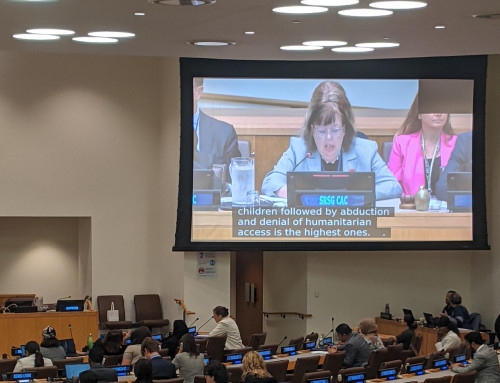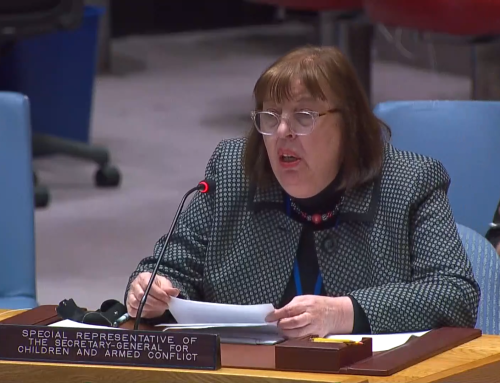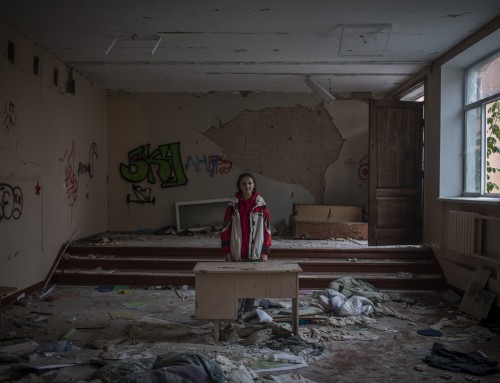UNITED NATIONS GENERAL ASSEMBLY
THIRD COMMITTEE
PROMOTION AND PROTECTION OF THE RIGHTS OF CHILDREN
Statement by SRSG Radhika Coomaraswamy
Special Representative of the Secretary-General for Children and Armed Conflict
Wednesday, 15 October 2008
Mr. President
Three years ago the General Assembly renewed my mandate and the mandate of my office to ensure that there would be an independent moral voice for children in armed conflict situations, working with member states, UN agencies, civil society actors and children themselves to make sure that they are protected from grave violations and that their rights are respected.
Though the general picture with regard to children and armed conflict continues to be bleak, there have been a number of positive and precedent-setting developments. One of the primary objectives of my office has been to end grave violations against children. With regard to the recruitment and use of children as child soldiers some progress has been achieved. The passage of Security Council resolution 1612 and implementation of a monitoring and reporting mechanism was an important part of this progress. UNICEF field staff and child protection advisors of DPA and DPKO, armed with this resolution and with the consent of the concerned government have begun to negotiate action plans with groups that recruit and use children. In Cote D'Ivoire, all five parties identified as violators have entered into action plans and released children, compelling the Secretary General to de-list them from the annexes of his report — the annex that is often called the ‘list of shame'. Similar Action Plans are being negotiated in Sudan, Sri Lanka, Myanmar, and Uganda. In May this year, I personally met with Commander Laurent of the APRD in the Central African Republic and he has recently entered into an agreement to release children into UNICEF custody. For all this we must thank you- the member states- for putting aside your politics and your immediate concerns for the sake of the children and for creating an important instrument in the struggle to protect children.
Nevertheless there remain 16 persistent violators who continue to recruit and use children and it is our hope that the Member States will live up to the challenge and set up a mechanism for determining targeted measures against these offenders. All these efforts and the end of the wars in Liberia, Nepal and Sierra Leone are leading experts to suggest that the total number of child soldiers in the world today has actually decreased and that there is a possibility that it will be further reduced in the near future. The dream of completely eradicating this terrible crime within the next two decades is now within the realm of reality.
With regard to the recruitment and use of children as child soldiers, our office has also filed an amicus curiae with the International criminal Court in the case of Thomas Lubanga. For the first time there is an international prosecution on the recruitment and use of child soldiers. We have argued that the legal interpretation of the term “recruitment and use” be determined case by case, using a functional test so that the different roles that children play in certain conflicts is also captured by the Court. Girl children are particularly affected by such interpretation and it is our hope that the girl child will also get her day of justice.
Unfortunately, there has been far less progress with regard to the other grave violations against children:- killing and maiming, sexual violence, abduction, denial of humanitarian access, and attacks on schools and hospitals. We feel that all these violations need our immediate attention and that in an ideal situation all the grave violations should be given equal weight. Moreover, sexual violence against girl children and boys is a heinous consequence of war and it is our belief that strong action should be also taken against those who sexually violate children.
Mr. President
A second objective of my office has been to raise awareness about the situation of children and armed conflict among stakeholders and the general public. The most important instrument for this advocacy has been the field visits that I have made to many zones of conflict. During the past year I have made field visits to Cote D”Ivoire, Iraq, the Central African Republic, Chad, and Afghanistan. I must thank all the member states who have invited me for their co-operation, for giving me access at the highest level of government and for their constructive engagement on the issues. I must also thank my UN colleagues in the field for their tireless efforts as well as NGOs and civil society for their advice and determination. They are the un-sung heroes on the frontline of the battle to protect children. They have often indicated to me that these high-level visits are fruitful, helping to facilitate dialogue on children's concerns and focusing greater attention on the most critical issues.
Finally I must pay homage to the children themselves and their families, many of whom retold their shocking stories with so much courage, hope and faith in their eyes. In Afghanistan I met with young girls in a school in Gardez. They were brave girls who defied those who were attacking girls' schools in an attempt to prevent girls from getting an education. One of the girls, who said her ambition was to be the governor of her province, asked me to take their story to the halls of the United Nations. “Tell them” she said, “Tell them about the poverty and violence we face and how we cannot even go to school!” Few children in the world have suffered more than the children of Afghanistan. Their trust in the United Nations, and the trust of so many children in situations of conflict, must not be betrayed and it is our hope that working with member states and our NGO partners we will continue to provide support and protection to these children.
In addition to the field visits, our office has attempted to mainstream the issue of children and armed conflict within the UN system, including presentation before the Human Rights Council and partnership with key agencies such as UNICEF, DPKO, OHCHR, UNHCR, DPA and the ILO. Our NGO advisory Group and the member states that are part of our Group of Friends continue to provide us with insight and support. Our media outreach and website continue to seek out the general public so that this issue has the support of civil society and international public opinion. Our office sees its role as a facilitator and an enabler, convening partners so that we can bring our collective force to bear for children.
A third objective of my office has been to make children and armed conflict an integral part of peacemaking, peacekeeping and peacebuilding. We are happy to note that over the last three years, a greater number of peace agreements have child protection provisions and demobilization programmes sensitive to the needs of children. We see this as a welcome development. We have also worked especially closely with DPKO and their child protection advisors to ensure that child protection and child protection training is mainstreamed into the work of the missions. We have continued to have a dialogue with the Peacebuilding Commission and UNICEF programmes to ensure that the needs of children affected by armed conflict are part of the rebuilding efforts in post conflict societies.
Mr. President
Despite some of the progress in these areas, serious challenges remain. Last year, ten years after the Graca Machel study, UNICEF and my office co-convened a ten year strategic review on the issue of children and armed conflict. The conclusions of the study were contained in last year's General Assembly report, and some of the critical themes and recommendations are also reflected in my report before you today. This review process has helped us to take stock of our on-going efforts and collaboration, and to identify some of the major challenges we face for the next few years.
The first challenge is to continue the fight against impunity and the need to end grave violations against children. There is now the legal architecture to do this both before the International Criminal Court and the Security Council, and we must continue to ensure that the promise held out by this architecture is fulfilled. In addition it is important to build national capacity to deal with these issues so that they do not warrant international attention. Already in some countries, recruitment and use of children is being criminalized and sexual violence against children is being prosecuted. These are welcome developments and should be encouraged with technical support and resources.
My visits recently to Iraq, Afghanistan, Israel and the Occupied Territories has increasingly convinced me that the main challenge we face for children and armed conflict lies in the changing nature of warfare where civilian life is far less protected. This is true not only in these countries but in many others facing what is termed a terrorist problem. Many insurgent groups are not only mobilizing children in their political and military activities but are using them as child suicide bombers. Some groups attack schools where children study regardless of the casualties and are particularly brutal with regard to girl students.
In response to the above developments we see children in military detention without adequate judicial process, and we see the use of aerial bombardment and precision bombing where collateral damage is an increasing factor. Children are often the innocent victims of these actions. Security checkpoints, the building of walls and humanitarian access also become issues of contention.
The fundamental principles of international humanitarian law which is the separation of civilian from combatant and the rule of proportionality are often breached. Member states must make it clear that the rules of engagement as defined by international law must be implemented and civilians, especially children, must remain a protected category.
A third challenge we face is creating innovative and successful programmes for the care and protection of children in these situations. Rescuing children is a laudable goal but that is only the beginning — the real struggle is the successful reintegration of these children back into the communities. UN country offices report that this is not as successful as we would like. Experience of the past decade points to certain principles that are essential in the reintegration of children .In this context we must thank the French government for its initiative with regard to the Paris Principles which will now guide all practitioners in the field. Any attempt at reintegration must involve inclusive community based programming, recognizing that programmes must be directed toward all children in the community. This is more effective because it prevents stigmatization of former child soldiers and helps local government and community workers develop the community with the child. Unless this is done, unless we work with the community and the parents, children find it very difficult to reintegrate. Most research studies show that the key to a child's successful reintegration is family and community acceptance. However, special programmes are also needed for children who fall between the cracks, girl children, street children and children who cannot, for one reason or another, go back to their homes. Children's agency, resilience and participation must be built upon.
For all of this child protection agencies and NGOs need adequate resources. I have promised my operational partners that I will use the weight of my office to advocate for their programmes and this remains one of my most critical priorities into the future. Though governments and donors are willing to fund emergency relief they are not always willing to stay the course to ensure that children are effectively reintegrated. Child soldiers, for example, fall between the cracks of emergency funding and development funding, each expecting the other to take the lead. Most funding is for a six to twelve month period while practitioners ask for a three year commitment to ensure longer -term sustainability of the key initiatives. We need to sensitize donors and governments based on our past experience and point out to them that the unsuccessful reintegration of child soldiers will have negative consequences, and indeed greater financial cost into the future. Many of the children may return to a life of violence and crime or be recycled in wars either in their countries or abroad. We have learnt such lessons the hard way in places such as Sierra Leone and Liberia.
Our success with regard to the mobilization of the international community on issues related to child recruitment should spur us on to protect all the rights of children in situations of armed conflict. The Machel review reminds us that achievement of the Millennium Development Goals is particularly difficult in situations of armed conflict. More than 2/3 of children under five who are undernourished live in countries with conflict. More than 2/3 of children out of primary school also live in armed conflict situations. This is a sobering realization and should propel us to devise the programmes and projects to ensure that the basic human rights of children are protected. Our concept of emergency must also include the provision of basic health, nutrition and educational services. Again, in close consultation with operational partners my office will continue to be an independent moral voice pushing these priorities.
Finally Mr. President, to remind all of us of the reality on the ground, I would like to recall the story of Rafiya, a little girl of seven who I met in the Central African Republic. She was a beautiful girl who was part of the nomadic community that moved between Chad, Cameroon, and the Central African Republic. Recently during one of their movements, they were attacked by the “coupeur des routes”, armed groups that function in the north west of the Central African Republic. Her parents could save only two children so they saved her brothers, carrying them on their shoulders and running to safety. The girl-child, left behind, was picked up by the leader of the “coupeur des routes”. She became his favorite and he showered her with gifts and special privileges. Just as she became attached to him, the army engaged the “coupeur des routes” and the leader was killed in front of her eyes. I met her with her grandmother who came forward to claim her. She has not spoken a word since her return. Discriminated by her parents, abducted by armed men and possibly violated she now faces a bleak future. Because of a lack of attention on the part of the donor community, she, along with most of the children of the CAR barely has shelter, no schools to go to, and little respite from the violence. They are visibly malnourished and the water they have to drink is brown and dirty. All the rights contained in conventions and resolutions are meaningless in this context.
Mr. President
Unless we redouble our efforts-, member states, UN agencies and NGOs — children like Rafiya will never have a future. It is imperative that we recommit ourselves to keep this agenda on the front burner, to focus and unify our collective efforts, to continue our advocacy and to ensure that the moral imperative to protect our children continues to over-ride all political considerations. I remain, with my office, at your service.
Thank You.





